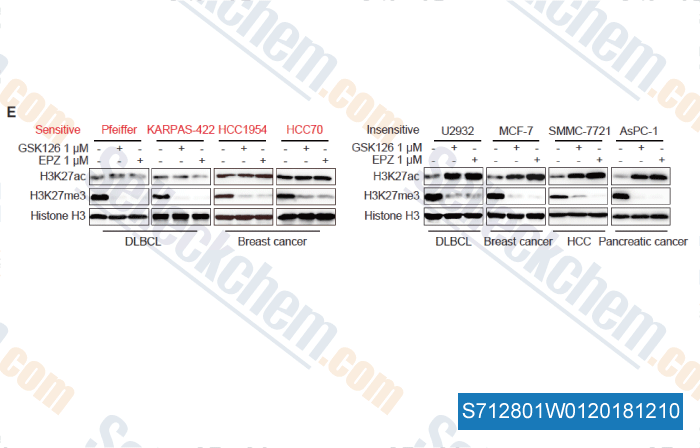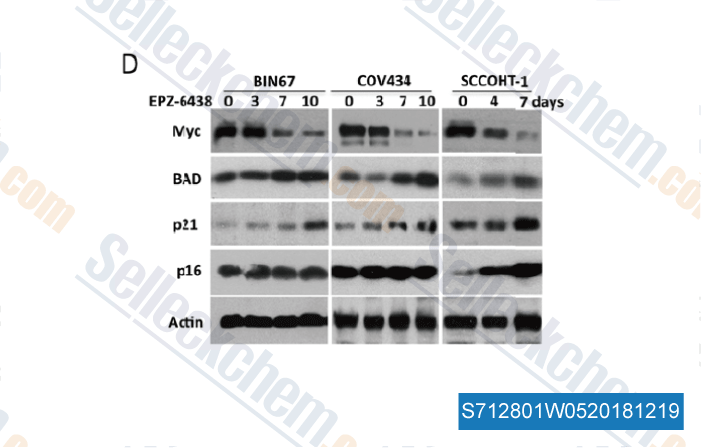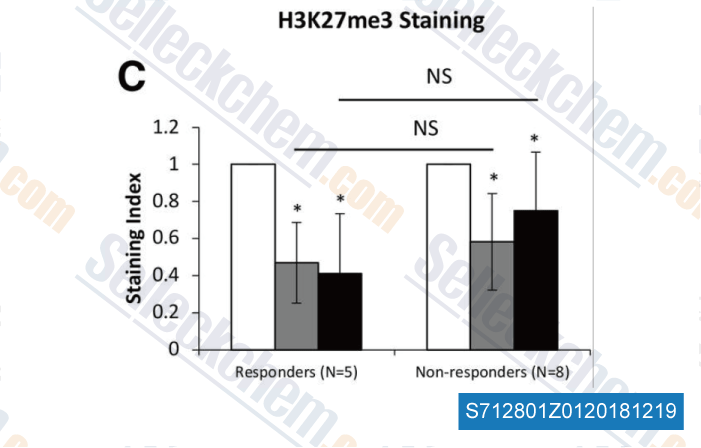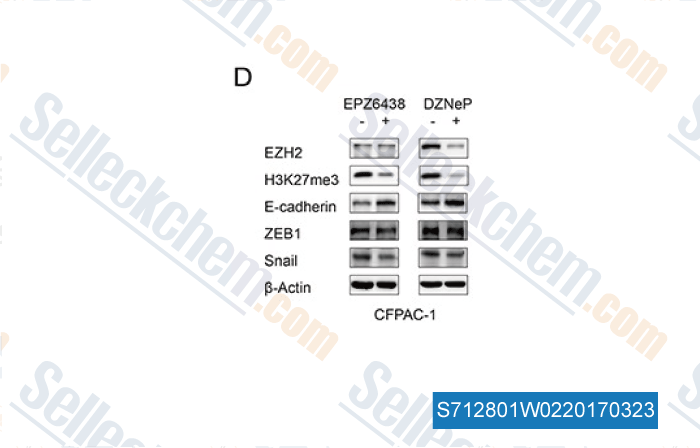|
Toll Free: (877) 796-6397 -- USA and Canada only -- |
Fax: +1-832-582-8590 Orders: +1-832-582-8158 |
Tech Support: +1-832-582-8158 Ext:3 Please provide your Order Number in the email. |
Technical Data
| Formula | C34H44N4O4 |
|||
| Molecular Weight | 572.74 | CAS No. | 1403254-99-8 | |
| Solubility (25°C)* | In vitro | DMSO | 100 mg/mL (174.59 mM) | |
| Water | Insoluble | |||
| Ethanol | Insoluble | |||
|
* <1 mg/ml means slightly soluble or insoluble. * Please note that Selleck tests the solubility of all compounds in-house, and the actual solubility may differ slightly from published values. This is normal and is due to slight batch-to-batch variations. * Room temperature shipping (Stability testing shows this product can be shipped without any cooling measures.) |
||||
Preparing Stock Solutions
Biological Activity
| Description | Tazemetostat (EPZ-6438, E7438) is a potent, and selective EZH2 inhibitor with Ki and IC50 of 2.5 nM and 11 nM in cell-free assays, exhibiting a 35-fold selectivity versus EZH1 and >4,500-fold selectivity relative to 14 other HMTs. | ||
|---|---|---|---|
| Targets |
|
||
| In vitro | EPZ-6438 concentration-dependently reduces global H3K27Me3 levels in wild-type or SMARCB1 mutant cells, and induces strong antiproliferative effects with IC50 ranging from 32 nM to 1000 nM in SMARCB1-deleted MRT cell lines. EPZ-6438 induces gene expression of neuronal differentiation and cell cycle inhibition, while inhibtis expression of Hedgehog pathway genes, MYC and EZH2. [1] The antiproliferative effect of EPZ-6438 is enhanced by either NSC-9900 or Hexadecadrol in several EZH2 mutant lymphoma cell lines. [2] |
||
| In vivo | In SCID mice bearing s.c. G401 xenografts, EPZ-6438 induces tumor stasis during the administration period and produces a significant tumor growth delay with minimal effect on body weight. [1] |
||
| Features | Orally bioavailable EZH2-selective inhibitor for both wild-type and mutant. Currently being tested in Phase II clinical trials for treatment of Diffuse Large B Cell Lymphoma. |
Protocol (from reference)
| Kinase Assay: |
|
|---|---|
| Cell Assay: |
|
| Animal Study: |
|
References
|
Customer Product Validation

-
Data from [Data independently produced by , , Cell, 2018, 175(1):186-199]

-
Data from [Data independently produced by , , J Pathol, 2017, 242(3):371-383]

-
Data from [Data independently produced by , , Clin Epigenetics, 2018, 10(1):121]

-
Data from [Data independently produced by , , Oncotarget, 2016, 7(10):11194-207]
Selleck's Tazemetostat (EPZ-6438) has been cited by 171 publications
| The NEXT complex regulates H3K27me3 levels to affect cancer progression by degrading G4/U-rich lncRNAs [ Nucleic Acids Res, 2025, 53(4)gkaf107] | PubMed: 39988317 |
| EZH2 inhibition sensitizes MYC-high medulloblastoma cancers to PARP inhibition by regulating NUPR1-mediated DNA repair [ Oncogene, 2025, 44(6):391-405] | PubMed: 39562655 |
| Genetic and epigenetic characterization of sarcoma stem cells across subtypes identifies EZH2 as a therapeutic target [ NPJ Precis Oncol, 2025, 9(1):7] | PubMed: 39789291 |
| Targeting PRAME directly or via EZH2 inhibition overcomes retinoid resistance and represents a novel therapy for keratinocyte carcinoma [ Mol Oncol, 2025, 10.1002/1878-0261.13820] | PubMed: 40101298 |
| EZH2/miR-142-3p/HMGB1 axis mediates chondrocyte pyroptosis by regulating endoplasmic reticulum stress in knee osteoarthritis [ Chin Med J (Engl), 2025, 138(1):79-92] | PubMed: 39704001 |
| AKT and EZH2 inhibitors kill TNBCs by hijacking mechanisms of involution [ Nature, 2024, 10.1038/s41586-024-08031-6] | PubMed: 39385030 |
| EZH2 inhibitors promote β-like cell regeneration in young and adult type 1 diabetes donors [ Signal Transduct Target Ther, 2024, 9(1):2] | PubMed: 38161208 |
| Tumor-derived G-CSF induces an immunosuppressive microenvironment in an osteosarcoma model, reducing response to CAR.GD2 T-cells [ J Hematol Oncol, 2024, 17(1):127] | PubMed: 39695851 |
| Increased translation driven by non-canonical EZH2 creates a synthetic vulnerability in enzalutamide-resistant prostate cancer [ Nat Commun, 2024, 15(1):9755] | PubMed: 39567499 |
| Inhibiting EZH2 targets atypical teratoid rhabdoid tumor by triggering viral mimicry via both RNA and DNA sensing pathways [ Nat Commun, 2024, 15(1):9321] | PubMed: 39472584 |
RETURN POLICY
Selleck Chemical’s Unconditional Return Policy ensures a smooth online shopping experience for our customers. If you are in any way unsatisfied with your purchase, you may return any item(s) within 7 days of receiving it. In the event of product quality issues, either protocol related or product related problems, you may return any item(s) within 365 days from the original purchase date. Please follow the instructions below when returning products.
SHIPPING AND STORAGE
Selleck products are transported at room temperature. If you receive the product at room temperature, please rest assured, the Selleck Quality Inspection Department has conducted experiments to verify that the normal temperature placement of one month will not affect the biological activity of powder products. After collecting, please store the product according to the requirements described in the datasheet. Most Selleck products are stable under the recommended conditions.
NOT FOR HUMAN, VETERINARY DIAGNOSTIC OR THERAPEUTIC USE.
